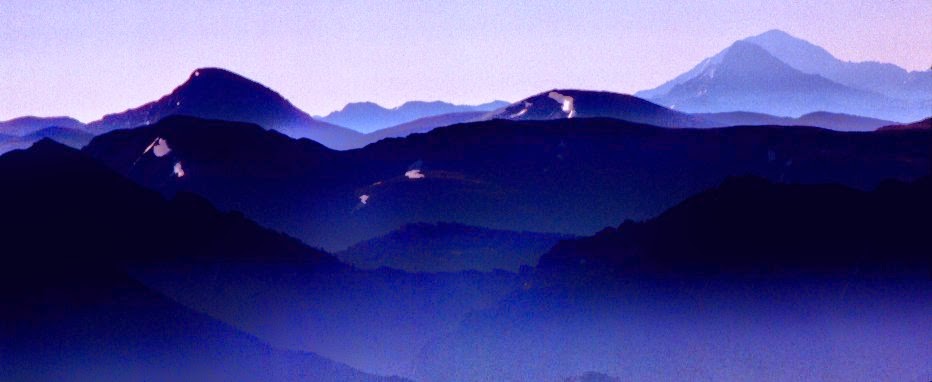Sacagawea called the Lemhi Mountains home, and she literally danced for joy when she saw these familiar peaks. When this area is added to the National Wilderness Protection System, as well it should be, it is my hope that this be designated as the Sacagawea Wilderness to honor one of our nation's most famous women.
Many of the peaks in the Lemhis are over 10,000 feet in height, some remain unnamed. This is the view from Lem Peak, looking south at sunrise.
The evening before, the sun had set in the west long before I reached my high-elevation campsite.
On the way back down, I descended from the stark realm above treeline to the realm of springs and seeps where vegetation gains a foothold on this rocky planet. Mountains always remind me of the fragility of life, and that the zone where life can get a foothold and thrive is not exhaustive.
At the southern end of the range wildflowers bloom, like this penstemon.
It was here that I saw my first Lark Sparrow. This sparrow is elegant and unmistakable with a single spot in the center of a clean breast, and a bold chestnut facial pattern.
The Lemhis contain Idaho's only natural arch.
There is a narrow slit canyon as well.
While involved with the conservation effort for this beautiful landscape I had the opportunity to speak with some of the local residents. One rancher said to me, "We just want it to stay like it is." Though the opinion expressed was intended to convey opposition to Wilderness designation, it struck me that Wilderness designation is the best way to assure this national treasure remains "like it is" for future generations.
Early one morning, at dawn, the airplane I was in climbed toward 32,000 feet and passed just south of the Lemhi Mountains. Here they are, in all their glory, with the Continental Divide to the east. This is fault-block mountain building, plate tectonics at work.
Wilderness designation for the Lemhi Mountain Range of Idaho is my primary unfinished lifetime goal. The opposition to Wilderness designation is largely philosophical, based on principle, not fact. There are no proven mineral reserves. There is very limited grazing in these high, brushy peaks. The thin line of slow-growing trees represent some of the poorest, least-productive forests in Idaho. If you were seeing this view at night, there would not be lights of civilization below. This is some of the best wildlife habitat remaining in Idaho. Herds of pronghorn travel the valleys and salmon spawn in the rivers.
This is about as wild, rugged, and majestic an American landscape as exists in the lower 48 states. It is protected only by remoteness, but as civilization encroaches on the last frontiers it is threatened by unrestrained off-road motor vehicle use. I do not deny that this is a beautiful place to ride a dirt bike or ATV. But, I have seen the lasting damage to soils and vegetation caused by the irresponsible behavior of uncaring thrill-seekers. The Forest Service has worked to rehabilitate some of the damage I brought to their attention, calling the situation "appalling." Suffice it to say that there is a "sport" in Idaho that consists of driving a 4-wheel drive vehicle through wet meadows (called "mudding") and up steep hillsides (called "hillclimbs"). The destruction to the landscape is indeed appalling. These mountains deserve better.











No comments:
Post a Comment